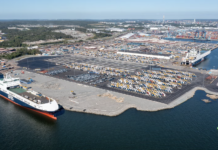
February saw 100 container ships ordered, the highest monthly demand on record according to Shipbroker Braemar ACM, mainly in the neo-Panamax range, 10-14,000TEU, with another 51 neo-Panamaxes ordered in March.
In total more than 160 ships have been ordered to date this year alone with around 65 in the larger bracket, while around 100 vessels of up to 5,100TEU have been ordered so far this year.
Net fleet growth in the 10-14,000TEU range of vessels was 3.5% in 2020, that is expected to more than double to 7.2% this year with the average growth in this sector expected to be around 5% for the ten-year period starting 2016 and ending in 2025.
Over the same 10-year period the larger ship sector will average more than 17% growth, with the mega-vessels remaining the ship of choice for carriers. Although, the average for these vessels is bumped up in the first five-year period, with major building for these vessels between 2016 and 2020 averaging 23.34% growth/year. In the second five-year period that growth is expected to have slowed considerably to an average of 10.84% annually.
According to industry sources, “Most of the neo-Panamax vessels ordered are probably ear-marked for Transpacific deployment, with a focus on North America and the capacity to be a flexible trader with the ability to transit the Panamax Canal. Though increasingly larger ships are now able to find employment on north south trades as port infrastructure developments encourage wider deployment opportunities.”
Brokers say that the decline in the feeder and regional fleets have averaged around 1.5 % since 2012, for ships up to 7,500TEU. Vessel orders of these ships are now expected to increase as the average age of the feeder fleet is already high, particularly in the smaller sizes. Overall the average age of the feeder and regional fleet is 16 ears old, with the majority of the older vessels in this sector falling in the sizes up to 3,000TEU.
In total 1.8 million TEU has been ordered this year, and brokers expect the full year to see 4.4% of the fleet on order, compared to 2.8% of the fleet in 2020.








